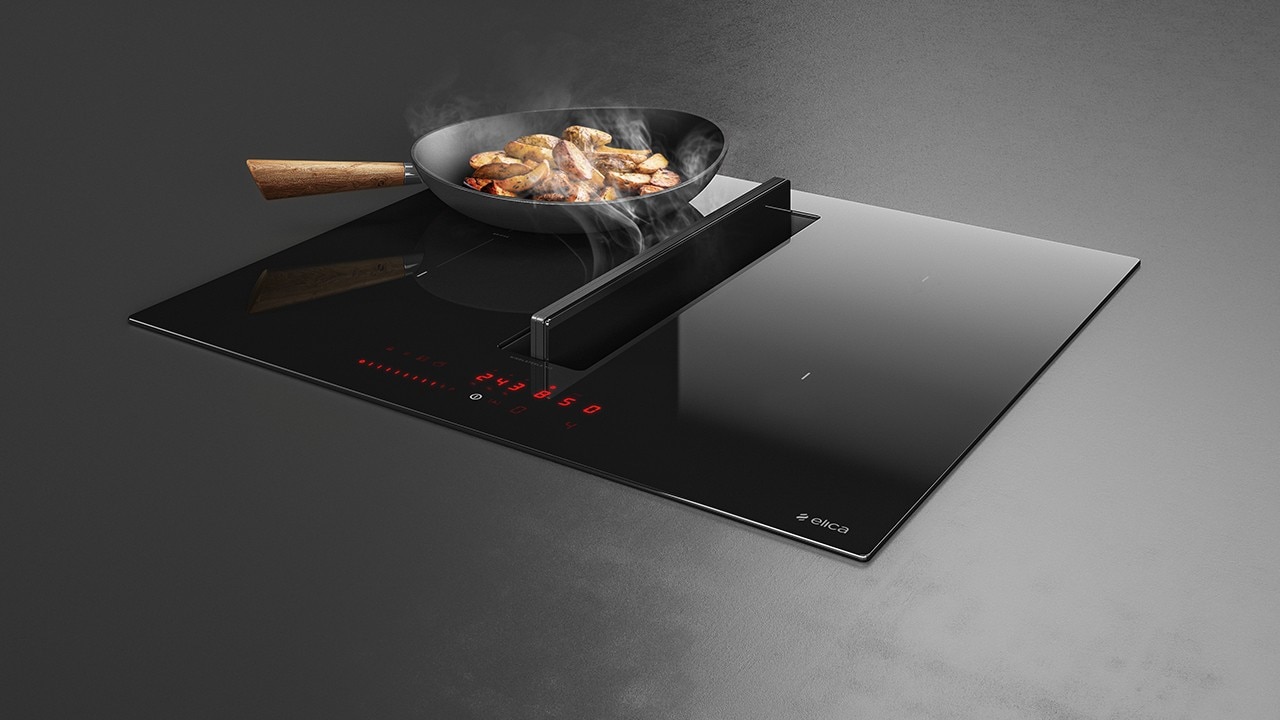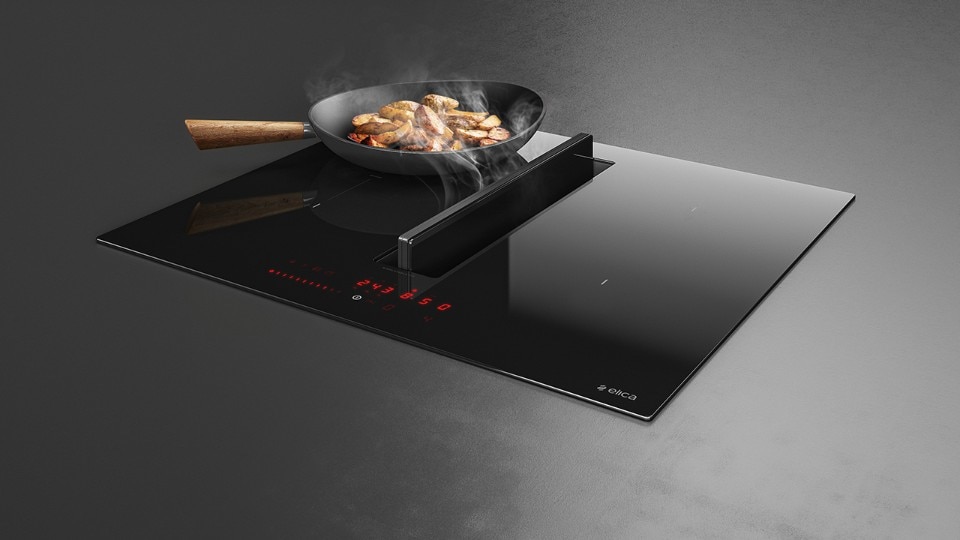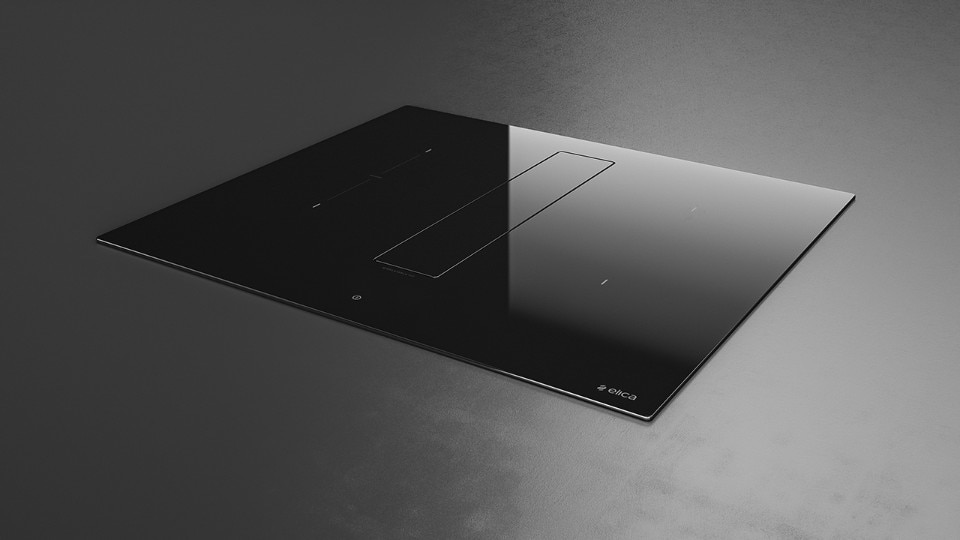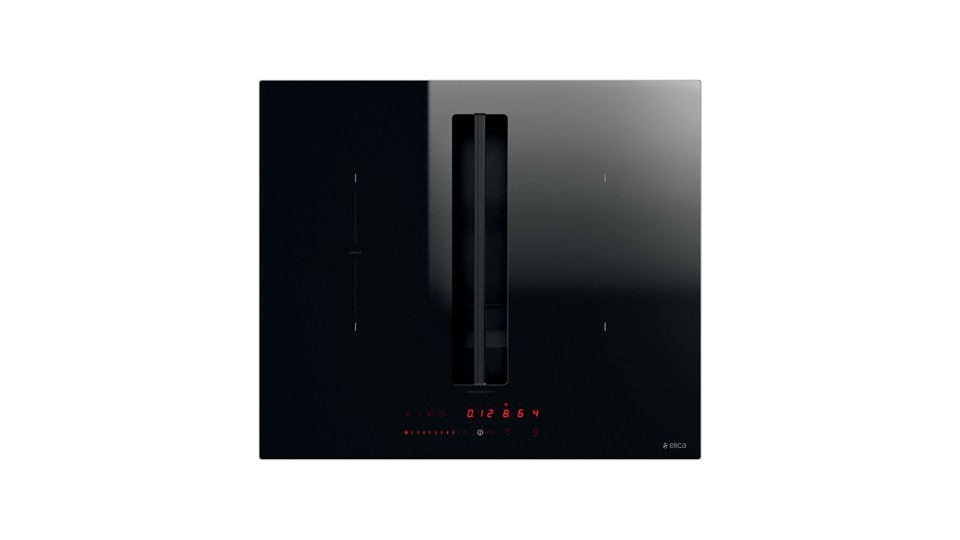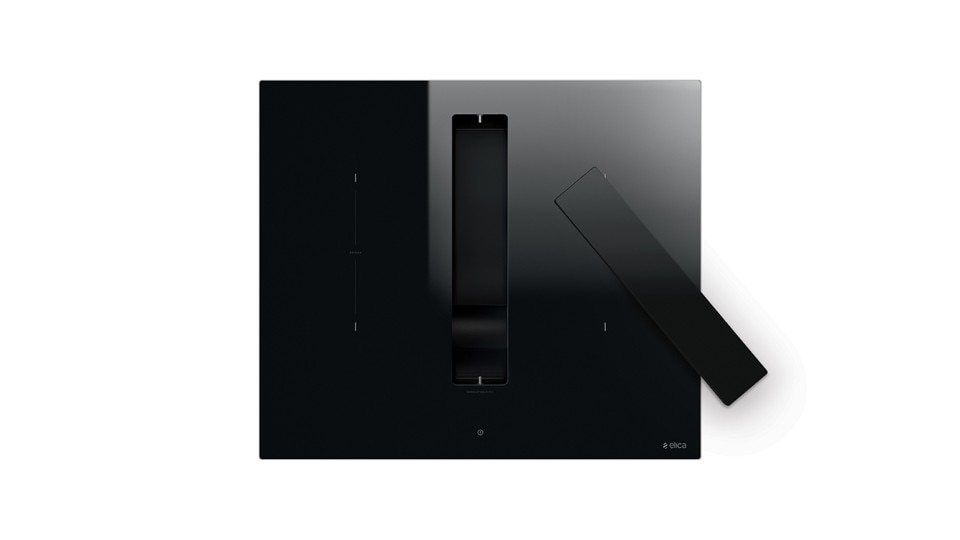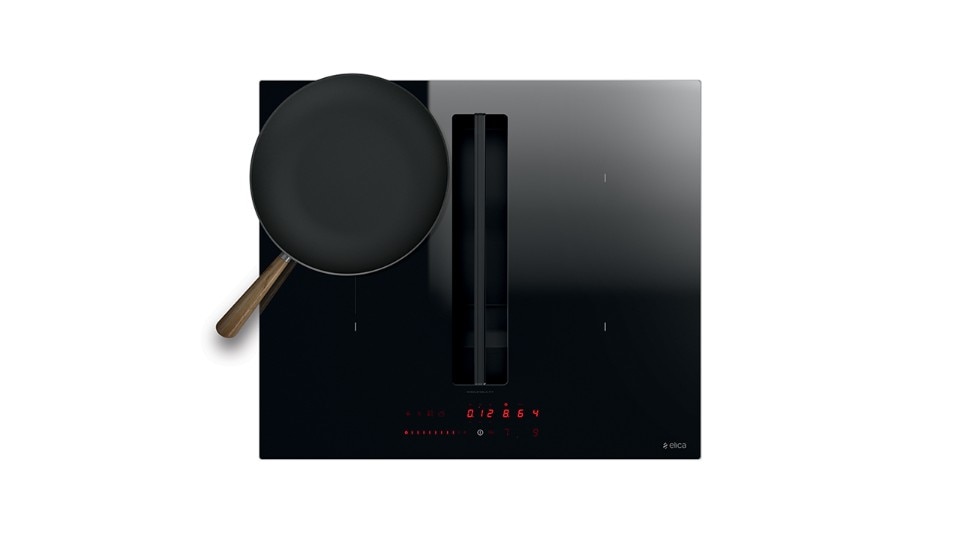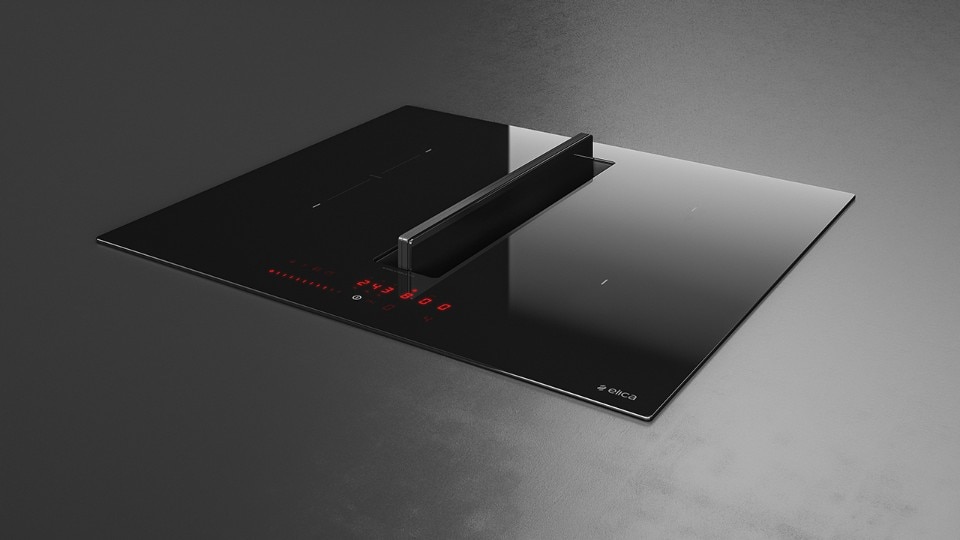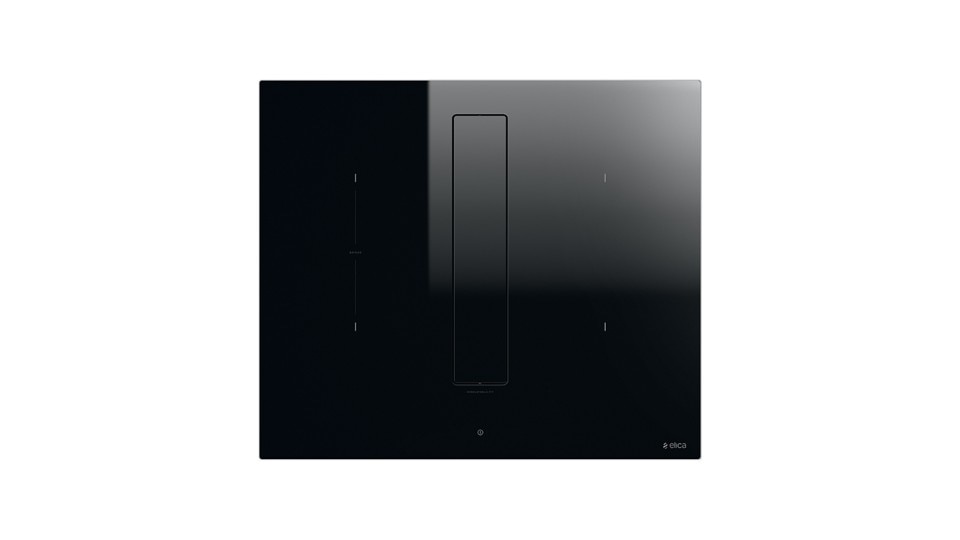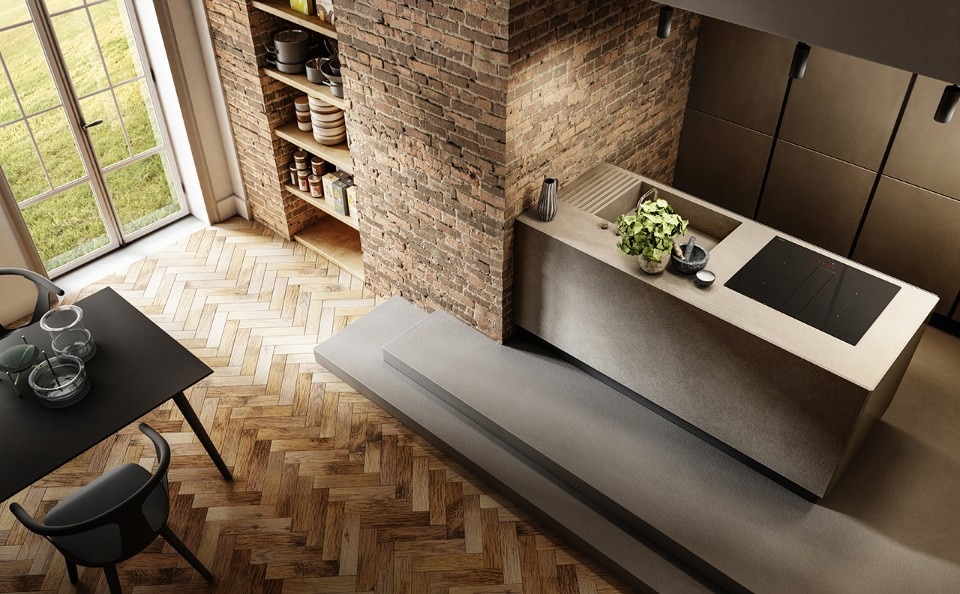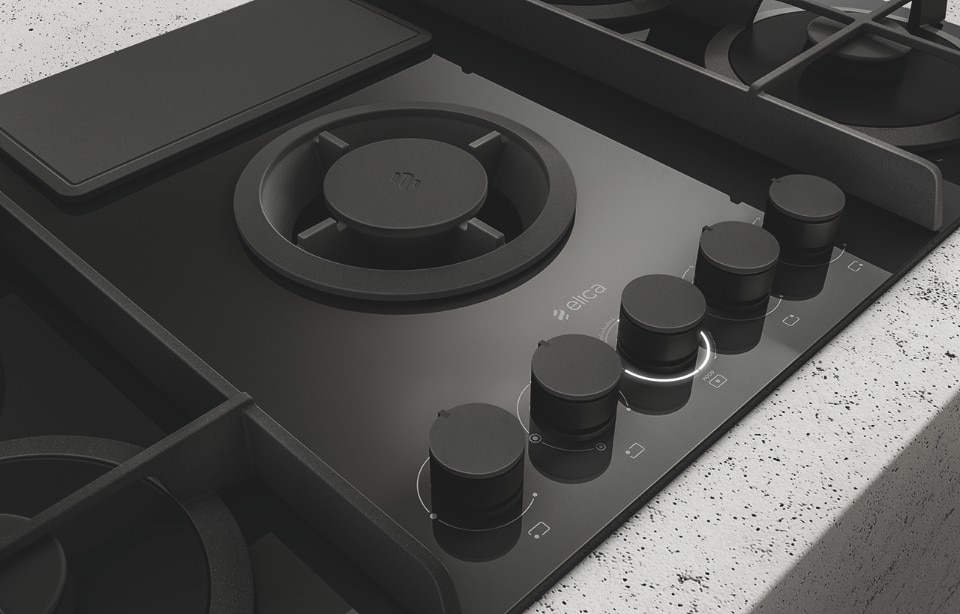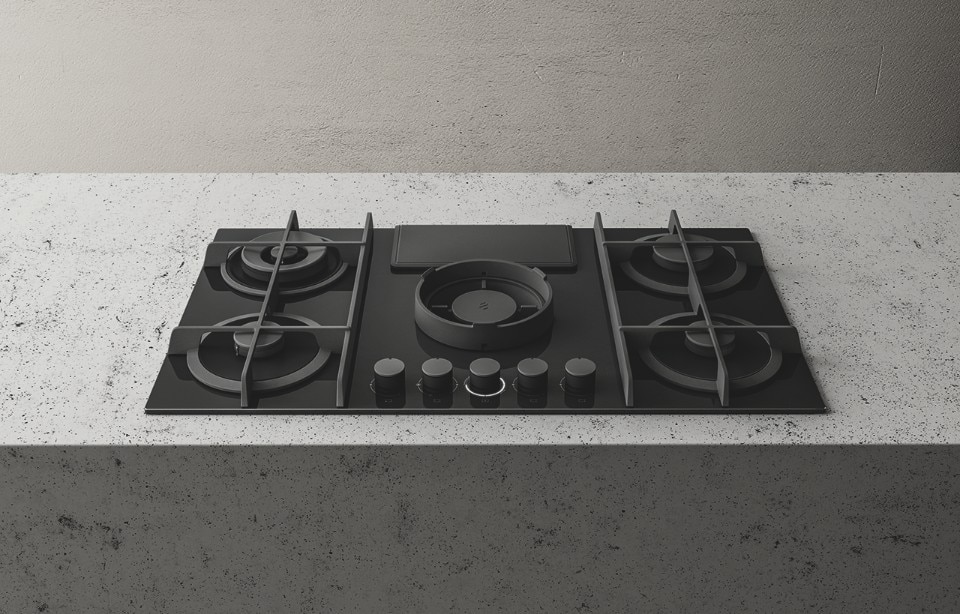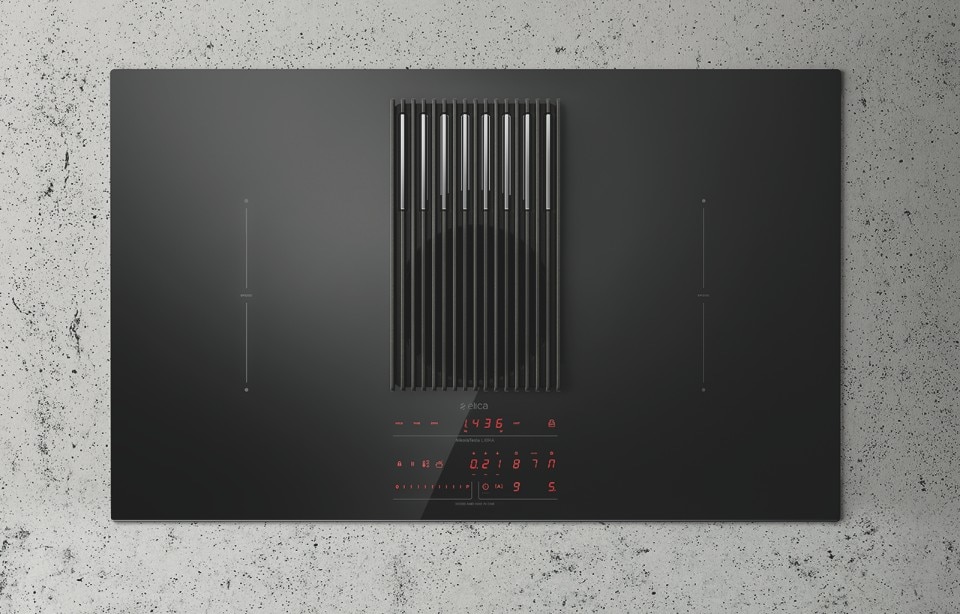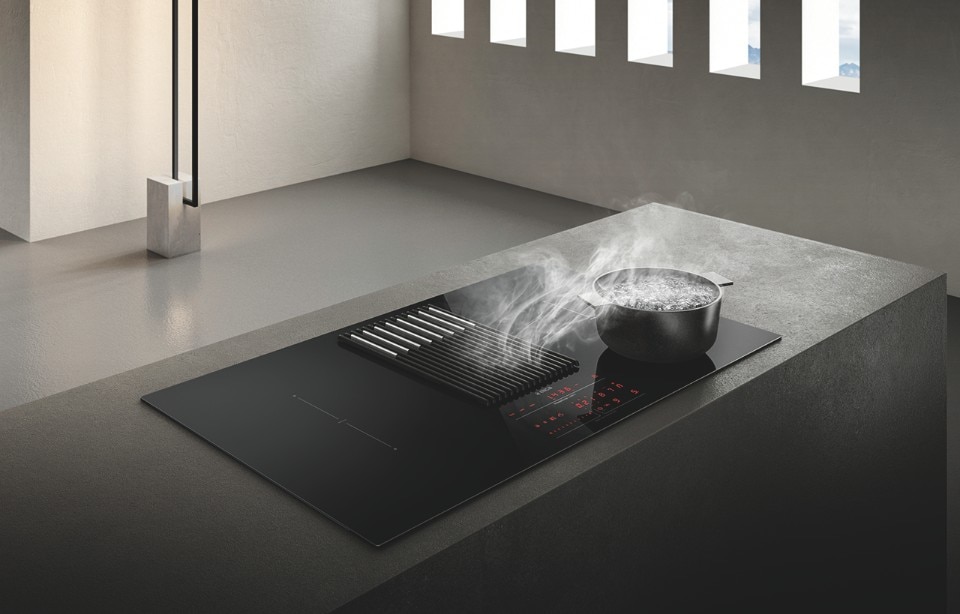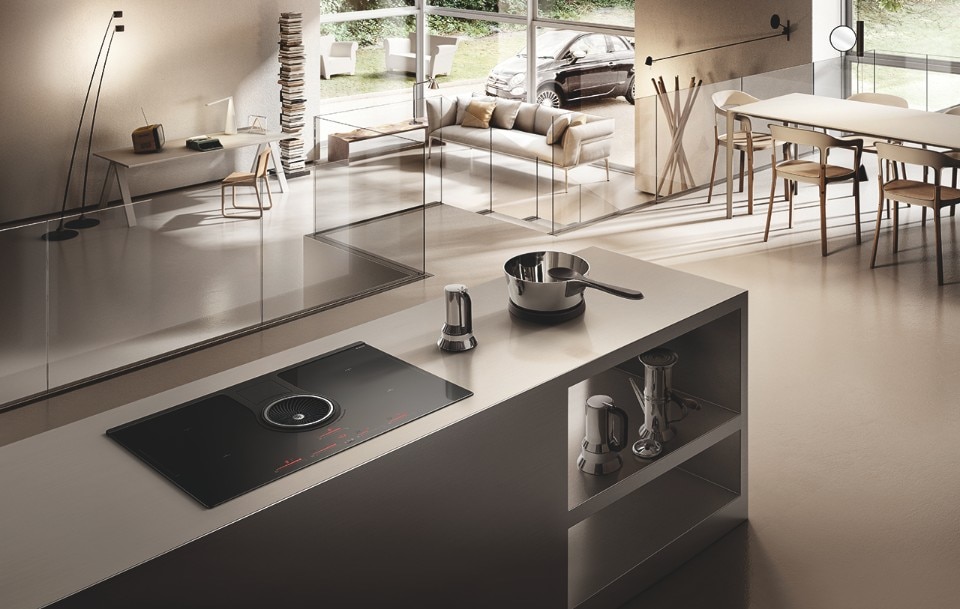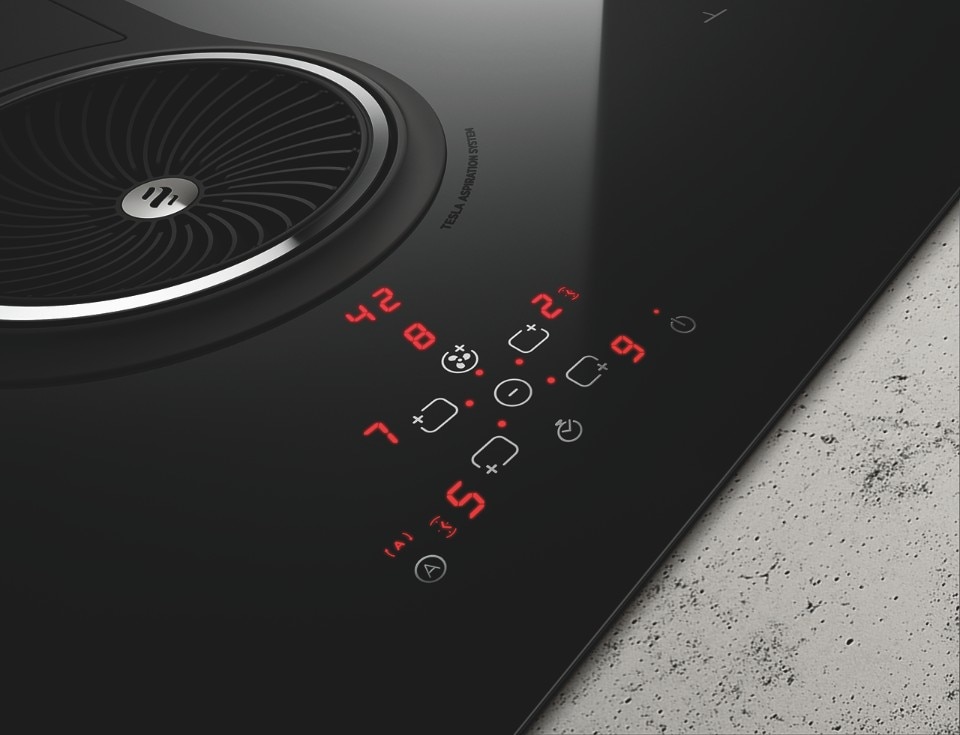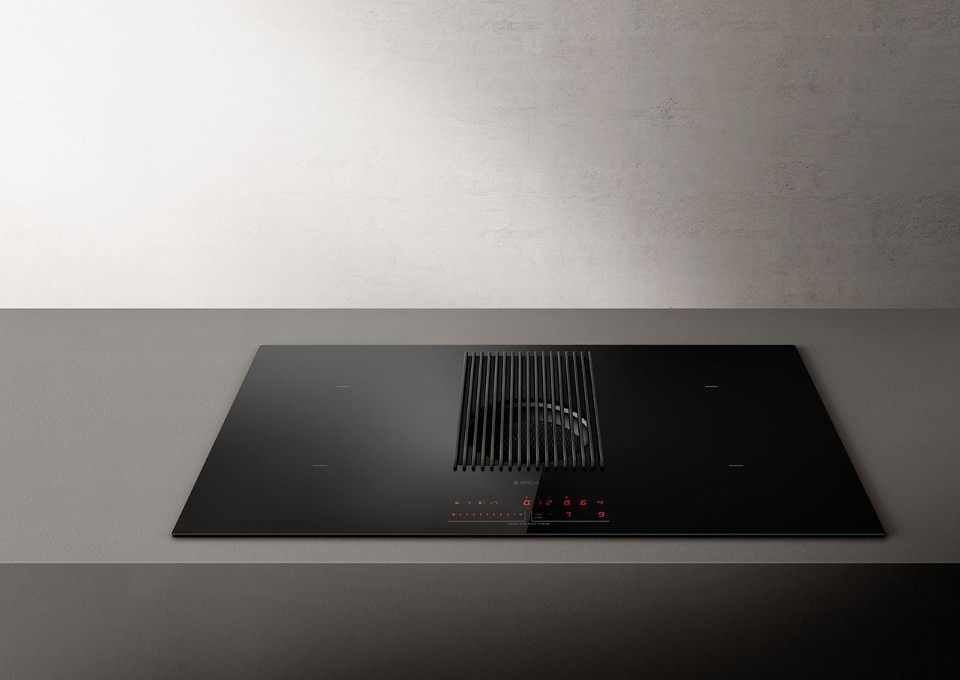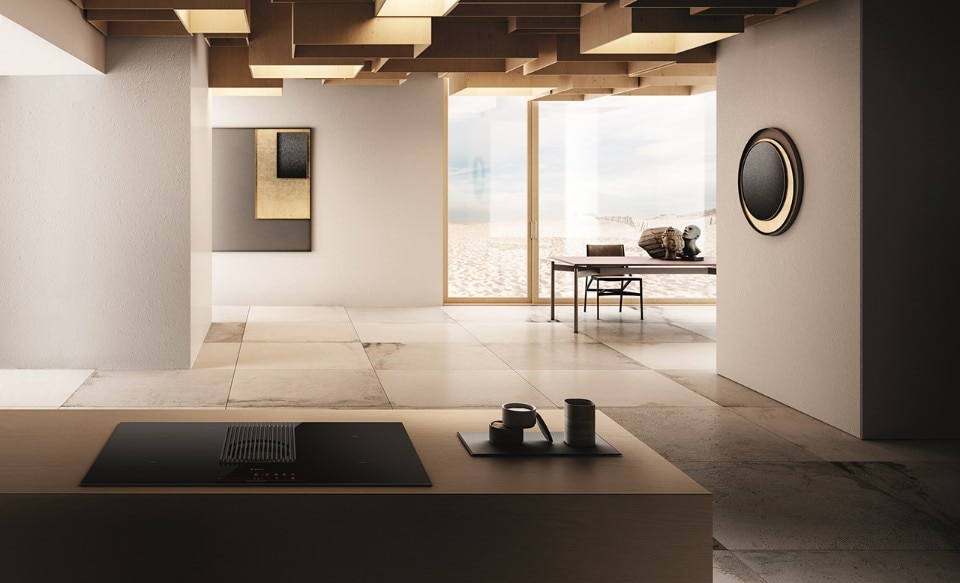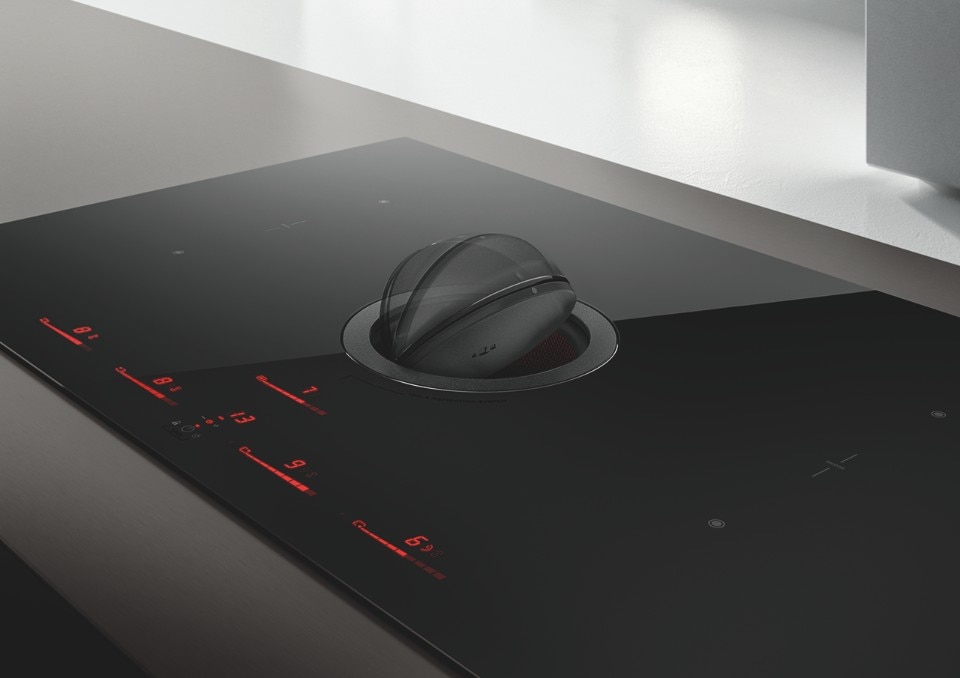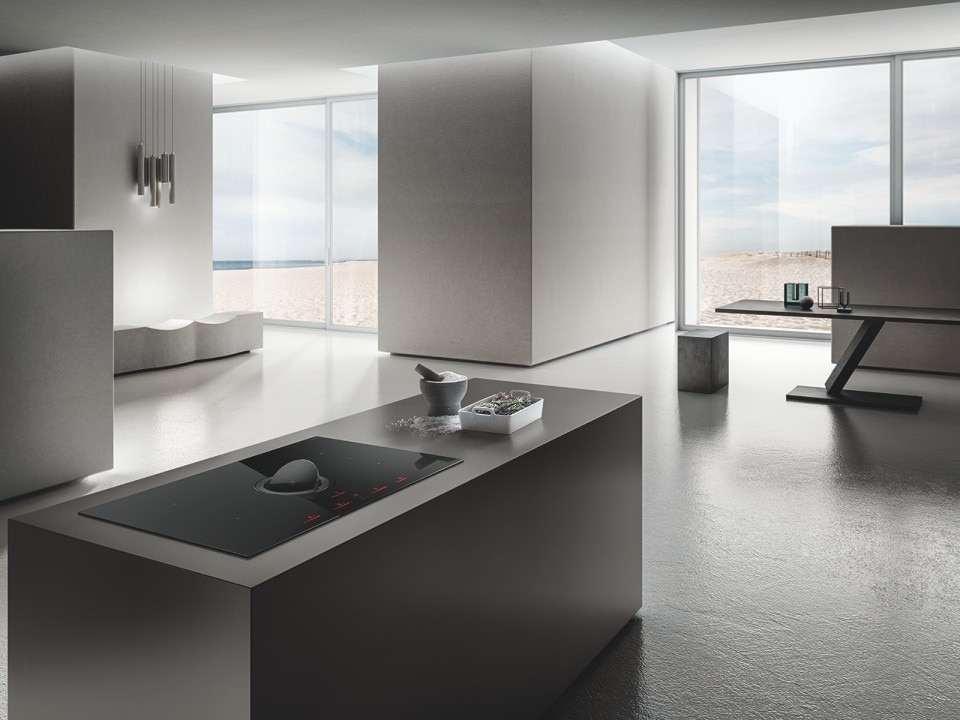Function and high-technology are the elements that distinguish NikolaTesla Fit, the new induction cooktop family with built-in aspiration. “The entire concept is based on researching a functional rather than aesthetic design,” its creator, Fabrizio Crisà, explains, “to achieve a balanced formal synthesis”. Revolutionary like the Serbian scientist with the same name, Nikola Tesla, seen by many to be “the man who invented the 20th century”, the series conceals a hood in the all-flush ceramic hob surface. The series was born with NikolaTesla One, awarded the Compasso d’Oro in 2018, and today includes six different models. With respect to the previous ones, NikolaTesla Fit is suited to 60 cm-wide cooktops. Aspiration is activated by opening the central part with a simple push, and the rotation is automatic thanks to a system of weights and magnets.
What is the strength of the NikolaTesla series?
It represents a revolution that radically changes the point of view in the kitchen. The function of the cooker hood, traditionally positioned above the cooking zone to support the rising trend of hot air, has been overturned and integrated inside the cooker hob, reversing the natural flow of fumes that are attracted downwards thanks to advanced fluid dynamics. Thanks to this new type of product, the hood in the traditional way leaves room for the induction hob which guarantees the treatment of the air through suction and filtration.
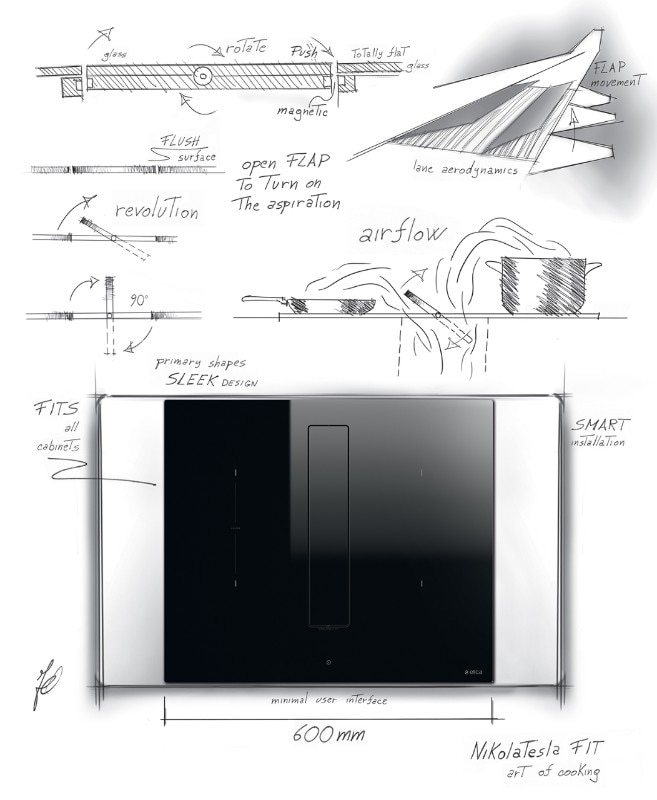
What innovation adds NikolaTesla Fit?
NikolaTesla Fit, compared to previous models, has been designed to be extremely compact, without sacrificing what the "older" brothers already offer. It represents a concentrate of technology in which cooking and suction are perfectly integrated in a space that allows installation even on 60 cm kitchen bases. Ideal for small rooms, but also for those kitchens where it is not possible to install independent hobs and hoods. The conceptual effort has focused on finding a balance between performance, functionality, ergonomics, technology, small size and versatility. The great challenge in terms of design was to be able to contain all these elements in a formal synthesis that gave life to an object with clean and essential lines. The extreme expressive simplicity is obtained through a glass flap that, when closed, makes the suction and the user interface invisible.
Why did you choose that name?
The name NikolaTesla, which characterises the entire series of Elica's aspiring plans, was strongly desired by the president of Elica, Francesco Casoli, a visionary entrepreneur who believes a lot in innovation and has recognised in this project the beginning of a change for its revolutionary character as much as the scientist from whom it took its name. Starting from this common root, NikolaTesla, I gave each model a specific name linked to its essence: the first is called NikolaTesla One; then the Switch version that, thanks to the rotation of a flap, changes its appearance and transforms when in use; Libra because it integrates not only cooking and suction, but also the scale; Flame combines fire and air, gas top with air suction; Prime has a primordial language that tells the cooking and is less sophisticated also in terms of functionality; and lastly comes Fit able to adapt itself, because it is compact, almost as if it were the result of so much fitness to get an enviable silhouette.
I live my work as part of my life; it always accompanies me and, more than formal search for things, I always look for change as improvement.
What makes you happy as a designer?
As a designer the thing that makes me happiest is the freedom to express myself. I live my work as part of my life; it always accompanies me and, more than formal search for things, I always look for change as improvement. I look, I observe the world and people and I imagine what the future will be like and what will really be necessary. This requires a vision and an innovative drive, first of all from us designers, but above all from our interlocutors. Succeeding in this kind of operation and finding ideas that revolutionize products on a conceptual level is certainly the thing that gives me the most satisfaction. The formal and aesthetic work is equally important, but I live it as an expression of a much broader vision.
What is your greatest fear?
My greatest fear is the passing of time, which passes quickly and is never enough to live and achieve everything you want. We live in a time crunch both at work and in our private lives and we always have to make choices. And the more ideas you have, the more you want to do, the less time you have. The biggest frustration is living with mental lists that start with “I would like to do...”, “I have a lot of...”, “if I can find the time I would like to try to...”, “if I could go back in time...”.
One designer you admire above all? Why?
Although I have admiration for many designers, architects, anthropologists or visionaries, without any doubt, the person I admire most and who I consider a great master is Dieter Rams. I believe that as a designer Rams has really changed the world and the idea of a product as an object that should satisfy and enrich people's lives. Innovative, conceptually revolutionary, formally essential and a lover of details, all features that are the basis of my design approach. I believe that Rams is a great master for everyone and my good fortune was to have met him during the ceremony in which he was awarded the Compasso d'Oro for his career in Milan. I also have a selfie with him, it was more exciting than if I had done it with Freddie Mercury.
What object changed your life?
If I had to say what object changed my life, I honestly couldn't answer that. My life has changed constantly and constantly because of events or objects, more or less invasive. During my journey there have been countless objects that have marked a change, sometimes conscious sometimes without realizing it. Banally, I remember when I still didn't know I was going to become a designer and I found myself in front of shop windows with all Alessi's products on display: I used to stare at them for hours, scrutinizing them, investigating every detail, reflection or curve, without knowing the reason, but above all without having the need, I just wanted them. And this, which had become an obsession, increased in me the dream of being able to make them myself one day.
Why did you decide to become a designer?
I don't know exactly why I became a designer. At first I was studying aeronautical engineering, it seemed to be the right choice, but then I looked inside and realized that it wasn't what I wanted. Today, the word design is very inflated, but when I chose to study Industrial design, I had no idea what it was and what it meant to do this job, but I had clear what I felt: the strong passion for products, the emotions, the curiosity and suggestions that provoked me, the moments when I took everything apart with my mind and reconstructed it in another way, the tendency to always imagine how to improve each object or how to find new features, the vibrations and feelings of falling in love in front of certain products. And so I realised that I had this problem, a disease, that only later I discovered it was called design. Today I wouldn't see myself in any other way, I think I was born there, like you are born a man or a woman, and you become tall or short, blond or brown, I think I was born with a congenital and acute form of "design-ism". And there's no medicine, it shows up suddenly, it doesn't make you sleep at night, it comes at the least expected moments, it makes you look like an alien when everyone drinks an aperitif and you just watch what the glass looks like, or when in front of a TV you find yourself behind the shelf to see what the back looks like.
I realised I had this disease, that only later I discovered it was called design. It makes you look like an alien when everyone drinks an aperitif and you just watch what the glass looks like, or when in front of a TV you find yourself behind the shelf to see what the back looks like.
If you could have a superpower, which one would you choose?
That's an easy question! I wouldn't want to supervise her, or climb walls, or even become invisible. As awesome as it would be, I wouldn't even choose to fly. The superpower I would choose is control over time. To speed it up, to slow it down, to go forward, to go backwards, to be able to do the wrong things again, to relive the happy moments a thousand times.
An object that makes you angry because it's totally wrong?
Maybe what makes everything abnormal today and that reminds us at all times how much the world has changed: the mask. An indispensable object, necessary at this moment, the mask is bullying its way into our lives, without the possibility of choosing. It is not like a pair of shoes, a T-shirt, a hat or sunglasses that we choose and wear to please ourselves more; on the contrary, it is an object that makes us anonymous, that hides who we are and makes our expression invisible. The mask on our face radically changes our relationship with others: our mood, grimaces, a hinted greeting remain behind the mask. We are now forced to smile (only) with our eyes. That's it, all this is wrong! And it is for this reason that in the last period it comes natural and spontaneous to me to try to imagine solutions and look for different ideas to solve the problem of individual protection without losing our identity.
What's at the top of your bucketlist?
In my bucketh list, in addition to having the superpower I was talking about before, there is the desire to find a greater mental balance that will lead me to live more peacefully and without the anxiety of always having to run. I believe that living at peace with oneself, detaching oneself a little from everyday problems, also bears fruit in the generation of ideas and that we focus on important things rather than always feeling in a blender. I am an imperfect being and unfortunately it is in my nature the desire to do more and better; I live in the maniacal search for perfection and this sometimes does not make me enjoy the successes and goals, but it always leads me to look at everything there is still to do.
When and how do you get the best ideas?
Best ideas come when I least expect them, when I don't look for them, sometimes they are the result of serendipity. The night before I fall asleep or when I'm alone in the car and I can't use my smartphone or computer, but I can only think: those are the best moments. I put ideas together, I concentrate, I divide problems, I focus everything, I enter a parallel state of mind, and everything takes shape. Then I return to Earth when I realize I've missed the highway exit... Always! But ideas never come by themselves, in general, I constantly accumulate information of all kinds: project specifications on which I work, marketing details, market analysis, target cost, target price, production plant, technological know-how, volumes, investment level and positioning. These are combined with analysis of sector trends, materials, new technologies. Loneliness serves me to put things in order.
Best ideas come when I don't look for them. The night before I fall asleep or when I'm alone in the car and I can't use my smartphone or computer, but I can only think: those are the best moments.
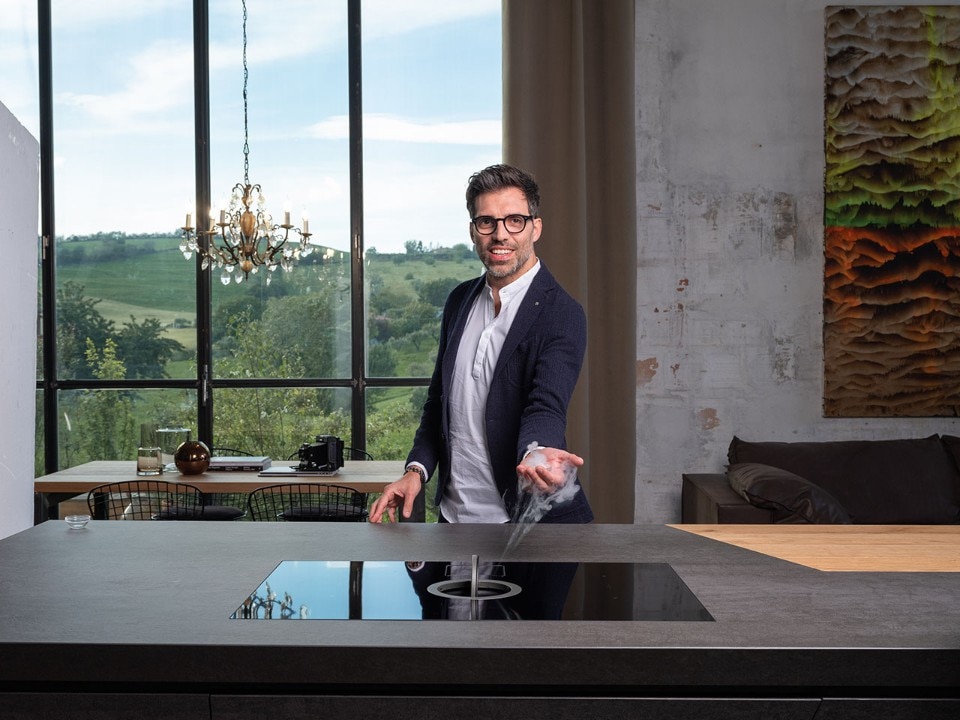
Advice to a designer whoʼs starting?
I don't think I'm the right person to give advice or have the authority to say "Stay hungry, stay foolish" as Steve Jobs did, also because I feel myself at the beginning of my journey, despite the fact that I've been doing this job for many years. Surely I can say that passion for what you do is the main thing, in my case passion is also obsession. In the beginning I would have worked for free to see my idea transformed into a product. Even today my only thought when I draw is to imagine that someone can buy that product, designed by me, and that they can be as happy and excited as I am when I buy something I like, so much so that I would embrace the person who designed it.
- Product name:
- NikolaTesla Fit
- Designer:
- Fabrizio Crisà
- Company:
- Elica
- Year of production:
- 2020


